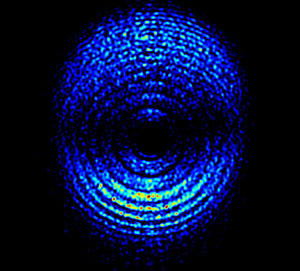I’m Not Sure about the Uncertainty (Indeterminacy) Principle
(c) Copyright 2011-2017 David Dilworth

Apple Bitten: courtesy Wikimedia
It is difficult to test the flavor of an apple without biting it or taking some sample out of it. You or I can test or measure its flavor by taking a bite of it or taking a small piece for examination. Either method of testing changes the apple irreversibly. Testing which harms or changes the tested phenomena or materials is called “Destructive Testing.”
When I take a photograph inside a building, where the light is dimmer, I usually use a flash.
Using a flash intentionally affects the subject of the photograph in a demonstrable way (a flash changes how someone looks in a photograph), and also in an unintended way — some people react to a strong flash of light in their eyes.
By contrast – photography without a flash does not affect the “model,” at least not with light.
Similarly, while X-rays show us the inner workings of some things, they also harm living photography subjects by damaging the DNA of living tissue.
Destructive Testing vs Non-Destructive Testing
Taking a bite out of an apple is clearly destructive. While flash photography is also “destructive” – it is rarely recognized that this is so. X-rays of living tissue are Destructive, but X-rays of metals – maybe not.
In Engineering we call the two analogous distinct types of methods non-destructive testing (or measurement) and destructive testing.
So what does this have to do with astrophysics? Well, Heisenberg’s Uncertainty Principle claims that you can not measure, or even know, a particle’s speed and position at the same time. In German it was called “Unschärferelation” or loosely in English “unsharpness relationship.” Heisenberg’s paper used the term “Indeterminacy” rather than the typical English translation to “uncertainty.”
Technically Heisenberg’s Uncertainty Principle actually has two claims : that accuracy of measurement of a particle’s position and momentum are inversely related;
and that accuracy of measurement of a particle’s energy and time are similarly inversely related.
However, I’ve wondered for a long time if the Uncertainty Principle was due to a lack of understanding of the two kinds of measurements or testing (destructive and non), and whether the “Uncertainty” experiments themselves were affecting or interfering with the particles.
The boundary between the two is not always clear. For example for some kinds of testing (testing metals for cracks) — x-rays are considered non-destructive, and for other kinds of experiments, such as on living tissue x-rays are clearly destructive. The key here is — does the testing affect the results of the experiment?
In any case, to most accurately measure any phenomena it is vital not to affect the phenomena you are examining. This really requires using non-destructive measuring techniques sometimes called “Passive” measurements.
Heisenberg and Destructive Testing
So I was rather amazed (and satisfied) to learn recently that indeed, Heisenberg originally did propose destructive measurement to establish the principle now named after him. He proposed using something far stronger than a camera flash to measure the position and momentum of an electron. Specifically, he wanted to shoot a gamma-ray photon (highly destructive) at a particle to see what happened.
Most importantly, Heisenberg fully understood his experiment was affecting the particles being measured.
What are analogous experiments ?
Seeing Underwater without Light or Sonar
Now I realize it is complex and difficult to measure particles and waves at the atomic level. Similarly, it is also complex and difficult to measure sea bottom surfaces without destructively “pinging” it with sound waves called SONAR.
However, researchers recently developed a passive method of “seeing” the sea bottom using ambient sound, without SONAR pings. Its called “acoustic-daylight imaging.”
Its not genuinely non-destructive because it uses ambient sound; “natural” sound of undersea phenomena. But the key part is the sounds are not emitted by the experimenter.
What it does demonstrate is that the experimenter is not interfering with the phenomena getting measured.
Non-Destructive Particle Testing Methods
Returning to particles, I suggest we need to examine carefully whether we are using non-destructive methods, and if not, we need to develop analogous passive non-destructive methods for particle detection.
I am not familiar with the newest methods used in particle physics to discern electrons, so if you know of a method that is “non-destructive” – please let me know.
Until we can fully non-destructively measure a particle’s position and speed, I must remain skeptical of Heisenberg’s Uncertainty Principle.
I look forward to learning your ideas on this.
References:
Seeing Underwater with Background Noise
Could marine mammals use ambient noise imaging techniques? – This article title is slightly misleading, but it does describe Ambient Noise Imaging.
Further reading:
What is the Heisenberg Uncertainty Principle?, by Andrew Zimmerman Jones
“Heisenberg’s Uncertainty Principle” in American Physical Society Journal, Feb 2008
“Scientists cast doubt on the uncertainty principle” R&D journal, September 2012
“2014 : What Scientific Idea is Ready for Retirement? : The Uncertainty Principle by Kai Krause”
“Demolishing Heisenberg with clever math and experiments” a paper in Physical Review X, 2012. While the article title is slightly misleading, this is a discussion of a clever way get around Uncertainty in some applications. This is a popular article about a paper entitled “Evading Quantum Mechanics: Engineering a Classical Subsystem within a Quantum Environment”
# # #




A little late to enter the discussion but since it is ongoing, you might like to consider the arguments in “Locality, Certainty and Simultaneity under Instantaneous Interactions” (see link below).
http://web.archive.org/web/20160226204204/http://www.quantumgeometrydynamics.com/blog/locality-certainty-and-simultaneity-under-instantaneous-interactions/